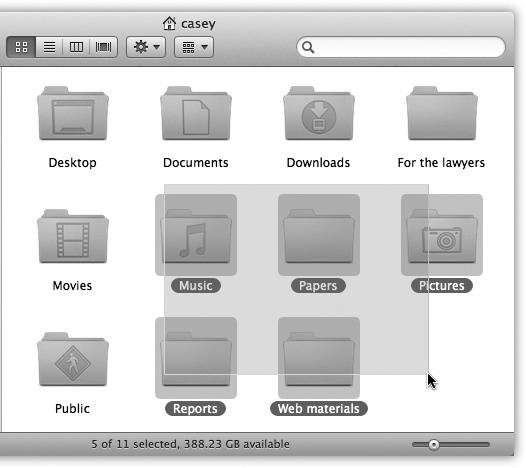To highlight a single icon in preparation for printing, opening, duplicating, or deleting, click the icon once. Both the icon and the name darken in a uniquely Lionish way.
Tip
You can change the color of the oval highlighting that appears
around the name of a selected icon. Choose ![]() →System Preferences, click Appearance, and use
the Highlight Color pop-up menu.
→System Preferences, click Appearance, and use
the Highlight Color pop-up menu.
That much may seem obvious. But lots of people have no idea how to manipulate more than one icon at a time—an essential survival skill. These techniques are essentially the same as in Windows, except that the keys you hold down are different.
To highlight multiple files in preparation for moving or copying, use one of these techniques:
To highlight all the icons. To select all the icons in a window, press
 -A (the equivalent of the Edit→Select
All command).
-A (the equivalent of the Edit→Select
All command).To highlight several icons by dragging. You can drag diagonally to highlight a group of nearby icons, as shown in Figure 3-2. In a list view, in fact, you don’t even have to drag over the icons themselves—your cursor can touch any part of any file’s row, like its modification date or file size.
Figure 3-2. You can highlight several icons simultaneously by dragging a box around them. To do so, drag from outside the target icons diagonally across them, creating a translucent gray rectangle as you go. Any icons or icon names touched by this rectangle are selected when you release the mouse. If you press the Shift or
 key as you do this, then any previously
highlighted icons remain selected.
key as you do this, then any previously
highlighted icons remain selected.To highlight consecutive icons in a list. If you’re looking at the contents of a window in list view or column view, you can drag vertically over the file and folder names to highlight a group of consecutive icons, as described above. (Begin the drag in a blank spot.)
There’s a faster way to do the same thing: Click the first icon you want to highlight, and then Shift-click the last file, just as in Windows. All the files in between are automatically selected, along with the two icons you clicked.
To highlight any icons. If you want to highlight only the first, third, and seventh icons in a window, for example, start by clicking icon No. 1. Then
 -click each of the others (or
-click each of the others (or
 -drag new rectangles around them). Each
icon darkens to show that you’ve selected it.
-drag new rectangles around them). Each
icon darkens to show that you’ve selected it.If you’re highlighting a long string of icons and click one by mistake, you don’t have to start over. Instead, just
 -click it again, so that the dark
highlighting disappears. (If you do want to start over, you can
deselect all selected icons by clicking any empty part of the
window—or by pressing the Esc key.)
-click it again, so that the dark
highlighting disappears. (If you do want to start over, you can
deselect all selected icons by clicking any empty part of the
window—or by pressing the Esc key.)The
 key trick is especially handy if you want
to select almost all the icons in a window.
Press
key trick is especially handy if you want
to select almost all the icons in a window.
Press  -A to select everything in the folder,
then
-A to select everything in the folder,
then  -click any unwanted icons to deselect
them.
-click any unwanted icons to deselect
them.
Once you’ve highlighted multiple icons, you can manipulate them all at once. For example, you can drag them en masse to another folder or disk by dragging any one of the highlighted icons. All other highlighted icons go along for the ride. This technique is especially useful when you want to back up a bunch of files by dragging them onto a different disk, to delete them all by dragging them to the Trash, and so on.
When multiple icons are selected, the commands in the File and Edit menus—such as Duplicate, Open, and Make Alias—apply to all of them simultaneously.
For the speed fanatic, using the mouse to click an icon is a hopeless waste of time. Fortunately, you can also select an icon by typing the first few letters of its name.
When looking at your Home window, for example, you can type M to highlight the Movies folder. And if you actually intended to highlight the Music folder instead, then press the Tab key to highlight the next icon in the window alphabetically. Shift-Tab highlights the previous icon alphabetically. Or use the arrow keys to highlight a neighboring icon.
(The Tab-key trick works in icon, list, and Cover Flow views—but not in column view, alas. You can always use the ← and → keys to highlight adjacent columns, however.)
After highlighting an icon this way, you can manipulate it
using the commands in the File menu or their keyboard equivalents:
Open (![]() -O), put it into the Trash (
-O), put it into the Trash (![]() -Delete), Get Info (
-Delete), Get Info (![]() -I), Duplicate (
-I), Duplicate (![]() -D), or make an alias (
-D), or make an alias (![]() -L), as described later in this chapter. By
turning on the special disability features described in More Gestures, you can even move
the highlighted icon using only the keyboard.
-L), as described later in this chapter. By
turning on the special disability features described in More Gestures, you can even move
the highlighted icon using only the keyboard.

